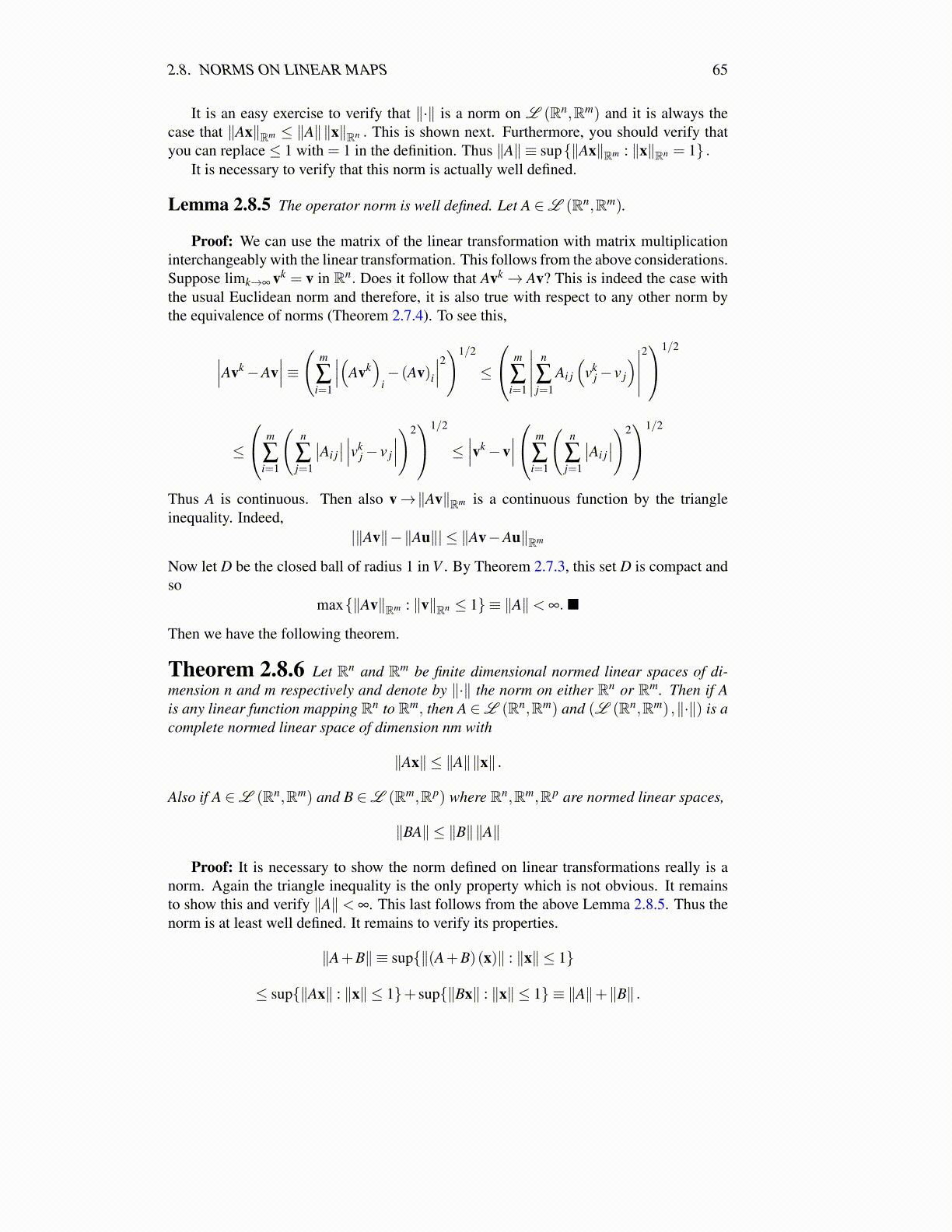
2.8. NORMS ON LINEAR MAPS 65
It is an easy exercise to verify that ∥·∥ is a norm on L (Rn,Rm) and it is always thecase that ∥Ax∥Rm ≤ ∥A∥∥x∥Rn . This is shown next. Furthermore, you should verify thatyou can replace ≤ 1 with = 1 in the definition. Thus ∥A∥ ≡ sup{∥Ax∥Rm : ∥x∥Rn = 1} .
It is necessary to verify that this norm is actually well defined.
Lemma 2.8.5 The operator norm is well defined. Let A ∈L (Rn,Rm).
Proof: We can use the matrix of the linear transformation with matrix multiplicationinterchangeably with the linear transformation. This follows from the above considerations.Suppose limk→∞ vk = v in Rn. Does it follow that Avk→ Av? This is indeed the case withthe usual Euclidean norm and therefore, it is also true with respect to any other norm bythe equivalence of norms (Theorem 2.7.4). To see this,
∣∣∣Avk−Av∣∣∣≡( m
∑i=1
∣∣∣(Avk)
i− (Av)i
∣∣∣2)1/2
≤
m
∑i=1
∣∣∣∣∣ n
∑j=1
Ai j
(vk
j− v j
)∣∣∣∣∣21/2
≤
m
∑i=1
(n
∑j=1
∣∣Ai j∣∣ ∣∣∣vk
j− v j
∣∣∣)21/2
≤∣∣∣vk−v
∣∣∣ m
∑i=1
(n
∑j=1
∣∣Ai j∣∣)21/2
Thus A is continuous. Then also v→∥Av∥Rm is a continuous function by the triangleinequality. Indeed,
|∥Av∥−∥Au∥| ≤ ∥Av−Au∥Rm
Now let D be the closed ball of radius 1 in V . By Theorem 2.7.3, this set D is compact andso
max{∥Av∥Rm : ∥v∥Rn ≤ 1} ≡ ∥A∥< ∞.■
Then we have the following theorem.
Theorem 2.8.6 Let Rn and Rm be finite dimensional normed linear spaces of di-mension n and m respectively and denote by ∥·∥ the norm on either Rn or Rm. Then if Ais any linear function mapping Rn to Rm, then A ∈L (Rn,Rm) and (L (Rn,Rm) ,∥·∥) is acomplete normed linear space of dimension nm with
∥Ax∥ ≤ ∥A∥∥x∥ .
Also if A ∈L (Rn,Rm) and B ∈L (Rm,Rp) where Rn,Rm,Rp are normed linear spaces,
∥BA∥ ≤ ∥B∥∥A∥
Proof: It is necessary to show the norm defined on linear transformations really is anorm. Again the triangle inequality is the only property which is not obvious. It remainsto show this and verify ∥A∥< ∞. This last follows from the above Lemma 2.8.5. Thus thenorm is at least well defined. It remains to verify its properties.
∥A+B∥ ≡ sup{∥(A+B)(x)∥ : ∥x∥ ≤ 1}
≤ sup{∥Ax∥ : ∥x∥ ≤ 1}+ sup{∥Bx∥ : ∥x∥ ≤ 1} ≡ ∥A∥+∥B∥ .